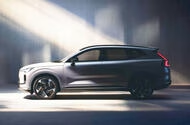Volvo is making waves again with the return of the XC70, a name that many car enthusiasts remember fondly. This time, however, it’s not just a nostalgic revival; the new XC70 is stepping into the spotlight as a long-range plug-in hybrid SUV, primarily aimed at the Chinese market. But what does this mean for the global automotive landscape? Let’s dive into the details.
What Makes the New XC70 Stand Out?
The XC70 is designed to cater to the growing demand for longer-range plug-in hybrids, especially in China, where consumers are increasingly looking for vehicles that offer both electric efficiency and the flexibility of a gasoline engine. With a promised electric range of up to 124 miles, this SUV is set to outshine its predecessor, the XC60 PHEV, which can only manage about half that distance. This leap in electric range is significant, especially for those who want to minimize their carbon footprint without sacrificing the convenience of a traditional engine.
Visually, the XC70 is slightly larger than the XC60 and has a design reminiscent of a scaled-down XC90. However, it’s built on a new platform specifically designed for range-extended electric vehicles (REXs), known as the Scalable Modular Architecture (SMA). This architecture is touted as a premium option for extended-range hybrids, although details about its relationship with other Volvo platforms remain under wraps.
Why the Focus on the Chinese Market?
China is currently the largest market for electric vehicles, and the demand for hybrids is on the rise. The XC70’s development aligns with this trend, as Volvo aims to tap into a segment that’s becoming increasingly popular among Chinese consumers. The company’s decision to explore additional markets later on indicates that they’re not just thinking short-term; they’re strategizing for a broader global impact.
Volvo isn’t alone in this venture. Other automakers, like Volkswagen with their ID Era range-extender concept, are also targeting the Chinese market with similar vehicles. This competitive landscape suggests a robust future for range-extending hybrids, especially as traditional electric vehicles face challenges in meeting consumer expectations for range and convenience.
What’s the Bigger Picture for Volvo?
Volvo’s CEO, Håkan Samuelsson, emphasizes that long-range hybrid technology serves as a bridge to full electrification. As the demand for pure electric vehicles (EVs) experiences fluctuations, hybrids like the XC70 provide a practical alternative for customers who may not yet be ready to fully commit to electric driving. This approach allows Volvo to maintain a balanced product portfolio while adapting to local market needs.
The XC70 also plays a crucial role in Volvo’s strategy amid a broader cost-cutting initiative. As the automotive industry faces various challenges, including economic turbulence and shifting consumer preferences, the XC70 could help stabilize sales and keep the brand relevant in a competitive market.
What’s Next for the XC70?
While the XC70 is primarily targeting the Chinese market, the possibility of a global launch remains on the table. This flexibility could open doors for Volvo in regions like North America and Europe, where the demand for hybrids is also growing. As more consumers look for sustainable yet practical vehicle options, the XC70 could find its place on roads worldwide.
The XC70 name may have been dormant since 2016, but its revival signals Volvo’s commitment to innovation and adaptability in a rapidly changing automotive landscape. With a focus on long-range capabilities and hybrid technology, the XC70 is not just a nostalgic nod to the past; it’s a forward-thinking solution for today’s drivers.
The big takeaway? The XC70 isn’t about perfection—it’s about smarter adjustments. Start with one change this week, and you’ll likely spot the difference by month’s end. Whether you’re an eco-conscious driver or just someone looking for a reliable SUV, the XC70 is poised to make a significant impact. Keep an eye on this one; it might just redefine what we expect from hybrids in the years to come.

